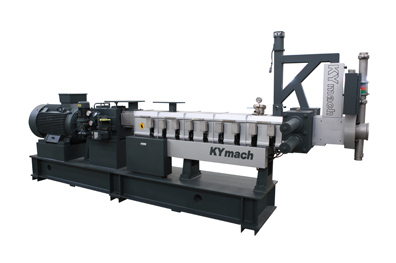The co-rotating China twin screw extruder has a high rotational speed and has a relatively close relative motion speed at different positions in the meshing zone, so it can produce strong and uniform shear.
The geometric shape determines that the longitudinal flow channel of the co-rotating dual screw extruder must be open so that material exchange occurs between the two screws. During the exchange, the material originally at the bottom of one screw groove will move to the top of the other screw groove. The opening of the longitudinal flow channel also makes it possible to open the transverse flow channel to realize the exchange of materials between adjacent grooves of the same screw.
The co-rotating twin screw design offers superior distributive mixing capabilities, making it ideal for mixing operations. The geometric parameters of the counter-rotating twin screw design ensure that its longitudinal flow channels can be sealed, thereby forcing the material to move forward through the screw, a process known as positive displacement.
This makes stable molding extrusion a key feature of a counter-rotating dual screw extruder. Therefore, when it comes to twin screws, the direction of rotation should be indicated.

From the perspective of the screw shape, the two screws rotating in the same direction are exactly the same, and the thread directions are the same. The two screws of the counter-rotating twin-screw extruder rotate in opposite directions, and there are two situations: inward rotation and outward rotation.
At present, there are few cases of inward rotation, because after the material is added from the feeding port, under the push of the two screws, the material will first enter between the radial gaps of the two screws in the meshing area, and form a material pile above. This reduces the free space of the screw groove that can be used, and ultimately affects the ability to receive materials from the feeder, which is not conducive to filling the screw groove as soon as possible and conveying the material forward. The feeding performance is not good, and it is easy to form bridges.
At the same time, the material entering the radial gap between the two screws has a force that separates the two screws and presses the screws to the barrel wall, thereby accelerating the wear of the screws and the barrel.
Outward rotation does not have the above-mentioned shortcomings. The material is quickly separated to both sides by the two screws, filling the screw groove, and quickly contacts with the hot barrel to absorb heat, which helps to heat and melt the material. In terms of appearance, the threads of the two counter-rotating screws are in opposite directions, one is right-handed and the other is left-handed, and the two are symmetrical.
Maintenance of Co-Rotation Twin Screw Extruder:
Regular maintenance of a co-rotation twin screw extruder is crucial to ensure optimal performance and longevity. One of the primary tasks involves inspecting and cleaning the screw elements to prevent material build-up and wear. Twin screw extruder suppliers often recommend a thorough cleaning schedule based on the specific materials being processed, such as filler masterbatch twin screw extruder applications. Additionally, lubrication of moving parts and checking for any signs of wear or damage are essential steps. Understanding the twin screw extruder working principle can help operators identify potential issues early and take corrective actions promptly. For those looking to invest in new equipment, there are various types of twin screw extruder options available, including small extruder for sale, which can be ideal for specific production needs.
Maintenance of Extruder Screw Elements:
The screw elements in a twin screw extruder are subject to significant mechanical stress and wear, making their maintenance a critical aspect of the overall upkeep. Regular inspection for signs of wear, such as thinning or deformation, is necessary to maintain efficient operation. Twin screw extruder suppliers often provide guidelines on the expected lifespan of screw elements and when replacements should be considered. Proper alignment and assembly of the extruder screw elements are also vital to prevent operational issues. For those using filler masterbatch twin screw extruder systems, it is particularly important to monitor the screw elements closely due to the abrasive nature of the fillers. When considering new equipment, exploring the different types of twin screw extruder can provide solutions tailored to specific production requirements.
Nanjing KY Chemical Machinery Co., Ltd. is currently the largest manufacturer of co-rotating parallel twin screw extruder in China and Asia, with an annual output of 250-450 units. More than 8,000 extruder systems have been installed worldwide, covering the chemical, plastics, textile, food and pharmaceutical industries. If you have any need, please feel free to consult us.
 Tel: +86-25-52706155
Tel: +86-25-52706155
 E-mail: info@kymach.com
E-mail: info@kymach.com
 No.59 West Tianyuan Road, Jiangning, Nanjing, Jiangsu Province, China
No.59 West Tianyuan Road, Jiangning, Nanjing, Jiangsu Province, China